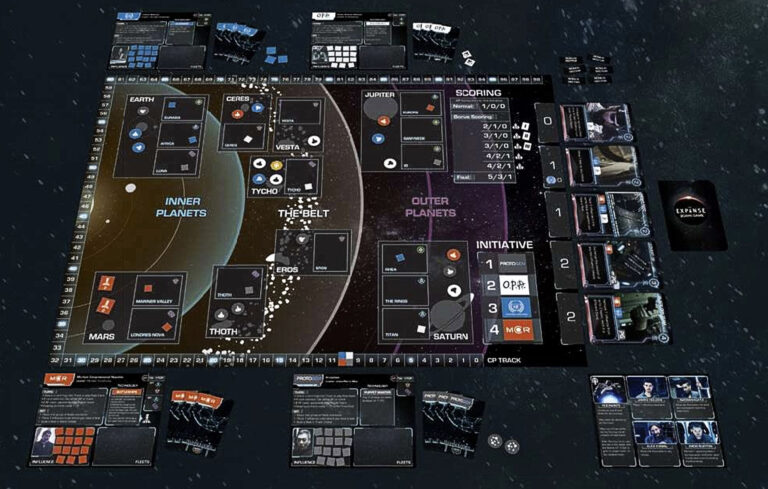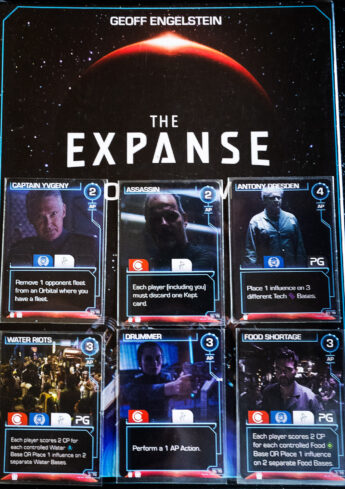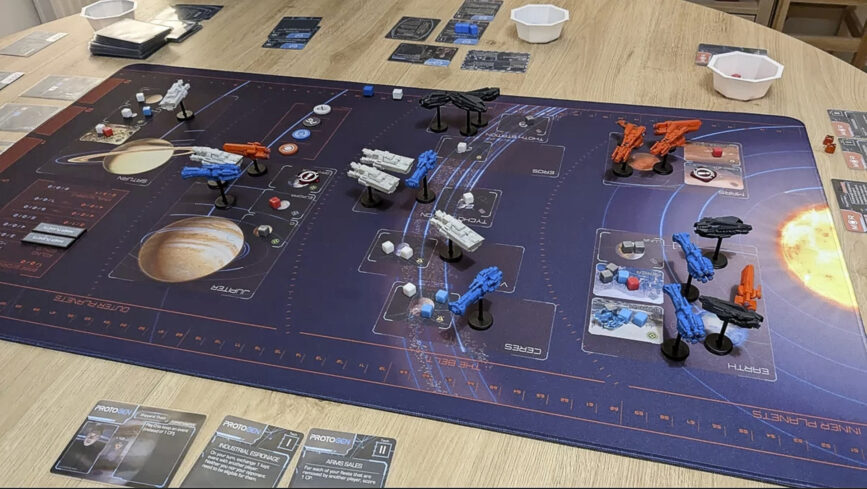Here’s our review for The Expanse boardgame and check out why this is considered a great multiplayer version of Twilight Struggle, a high-ranking game on BGG.
I’ve been a SciFi nerd all my life and amongst the recent shows and books, The Expanse has really captured my interest. The first few books and the first seasons of the franchise really nails what science fiction does best – shows us a glimpse of the future based on present science; touches on geopolitics that seem both distant and familiar at the same time; has relatable, flawed protagonists who can both be dumb and brilliant at times; all while keeping the plot and ‘tech’ aspects still accessible to the common man. Now the franchise has a boardgame. Is it as good as the show and the books? Lets find out…
What’s in the Box
The box includes a gameboard of our solar system mainly divided into the Inner Planets, The Belt and Outer Planets; four factions maps representing the four playable factions, the United Nations of Earth, the MCR (Mars faction), the OPA (an alliance of outer planets), and Protogen. Each faction has their set of influence cubes. fleet tokens, initiative tokens and factions specific token – 2 battleships for MCR, 2 scrap ships for the OPA, and 2 protomolecules for Protogen. There is also another mat, the Rocinante mat that also comes with its own token, that represent the protagonists in the show and act as a catch up mechanism for the game (more on this later).

game setup
The engine driving the game are the 52 Action Cards and 6 Score Cards that allow players to perform actions and powerful events in the game; and also allows players to score victory points.

card design. minimalist, functional and quite drab
The game is published by Wizkids which has a reputation for putting out boardgames with average quality components and it shows in The Expanse. The cards are of average card stock and will have to be sleeved. The graphic and art design of the game does have a minimalist scifi feel, though reminiscent of the show, it looks spartan and functional. The card images are taken from the show but card design and image quality and resolution are average. The same can also be said of the box design, it is quite bland and does not stand out in a game shelf. This is not a game with good table presence because of its components. But many users (including myself) have upgraded the components to give the game a better aesthetic feel.
Geopolotics in Space
The Expanse is a two to four player game of area control. The game is asymmetric, each faction has its own technology levels, bonus areas and Special units. But the basic actions are the same for all factions, so it is not asymmetric as the game Root, where you’re basically learning to play the game differently per faction. This makes learning The Expanse and playing each faction quite easy to grasp.
A player wins by amassing the most number of victory points, known as Control Points (CP) in the game. In a turn, a player has two options, select a card from the track or play an Event they have kept from an earlier round.
The game board has an Action Track with five cards that all players can see. The position of the card on the Track indicate its points to play. The player pays the corresponding points in CP to play his preferred card – thus spending valuable victory points (CP) to play the cards of your choice.
If the player chooses an Action Card, he can play that cards event ( which are situationally very powerful actions) if his faction symbol appears on the card; otherwise he can use the Action Card’s Action Points to perform the game’s basic actions which includes moving ships, placing influence cubes and building fleets. After the active player spends his Action Points, another player (whose faction symbol appears on the card) may choose to play the Event, and the non active players highest on the initiative track has the first option to choose the event.
A third option is to keep the card as a Saved Event to be played later on in the game.
If the player chooses a Scoring Card, the active player secretly chooses a Bonus Sector. Each player then has the option to play one Kept Event or activate a Rocinante Event. Each base on the map is then scored based on influence, faction bonuses and Orbital Control (number of fleet units); and points scored per base (CP) is based on the Bonus Sector secretly chosen by the active player. So if the active player (secretly) chose Inner Planets as the Bonus Sector, bases located in that Sector will score the highest for this scoring round. The player with the lowest score gets to control the Rocinante till the next scoring round, as a catch up mechanism.
The above is a very concise summary of play. Those interested in learning the full game rules may download the game manual here:
https://wizkids.com/posters/repository/wizkids/TheExpanse-RulesWEB.pdf
Multiplayer Twilight Struggle
The game’s setting is basically the first two seasons of the Amazon Prime series, which, in my opinion, are the best seasons of the show. Gamers familiar with the show will definitely recognize events and personalities depicted in the Action Cards and their in game effects reflect what they represent. The faction and Rocinante mats are very good at emphasizing the different faction abilities in the books and show; and as minimalistic as the game looks, it does evoke the different info screens from the series itself. So from a thematic point of view, The Expanse boardgame is a winner.
The Expanse has been called multiplayer Twilight Struggle by many boardgame reviewers, and very aptly so. Just like the popular two player game set in the Cold War, The Expanse is a game of geopolitics where you gain points, not thru battle – although there is that in the game, albeit abstractly, but through having the most influence at key locations at critical scoring phases. This is a card driven game of direct conflict. Your gains during your turn can easily be undone in the succeeding players’ turns; however games are usually tight with multiple opportunities to shore up your influence or stifle your enemies’ plans.
The Action Card Track is particularly well done. Each player can see what cards are available to play and cards that have been on the board longer (those to the left) are cheaper to play than newer cards (to the right.) This adds an interesting dynamic as to what card to play as newer cards may provide scoring opportunities or powerful events but will cost you in terms of victory points to play.
Card play is also very well designed. Like Twilight Struggle, the use of Action Points and Events give interesting strategic options. Using a card with many Action Points exposes you to the risk of other players being able to use it’s Event. And since there are more players/factions in The Expanse, the chances of another player using said Event is increased. Also, being able to have a Kept Event to be used later, especially in a scoring round, could be critical to you gaining 20 CP vs 2 CP.
Card design and Basic Actions are also unique compared to Twilight Struggle. In The Expanse, none of your basic actions can eliminate enemy fleets and influence; you can only do this through the use of Action Card Events. This is quite different from Twilight Struggle where basic actions can eliminate or displace enemy cubes. This makes Events that attack opponents extremely valuable in The Expanse, and players will undoubtedly be fighting over these cards or denying opponents of their use.
Aside from adding thematic flavor, the technology levels and special units of each faction also enhances strategic play. You will definitely have to play to your strengths, which are not that obvious on initial playthroughs, to optimize your gameplay. The Rocinante mat also adds fleet strength and has very interesting and powerful abilities that can help the player lagging in CP gain momentum after a scoring round.
The interesting thing is, with all these new gameplay designs (vs Twilight Struggle), the game is actually easier to learn and play. It does away with the minutiae of rules that made Twilight Struggle more complex (ie DEFCON levels) and longer to play. The Expanse also plays decent as a two player game, but it really shines as a three or four player affair.
The game has theme, ease of play, is good a variable player counts, has good and novel mechanics, and provides strategic depth – so why isn’t this game more popular? For one, the IP is quite niche. The series and books do not come close to the mass appeal of Star Wars or Star Trek and is more of “nerd fodder”. But the major reason is likely because of the look of the game itself. It just doesn’t stand out on the shelf nor the gaming table. Gamers, especially those who like table presence and nice boxes, can easily overlook this game.
And that really is a shame. If you are a fan of area control, there is a lot of game in this box. As mentioned above, many fans on BGG have gone to lengths customizing the game, and their efforts really make the game look and feel better. Below is an example of custom work done by TomB posted in BGG. If you are willing to look past the minimalist, bland art design or are willing to customize and hit those 3D printers, give The Expanse a go, I don’t think you will be disappointed.

customised game by TomB
Review Score: 7.5/10
Related articles:


